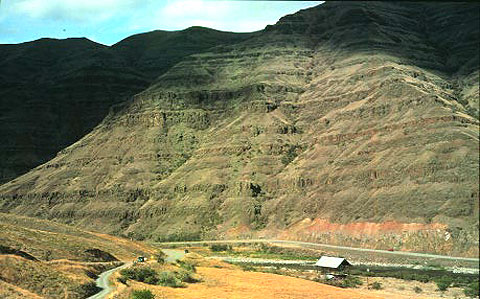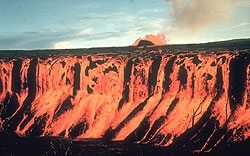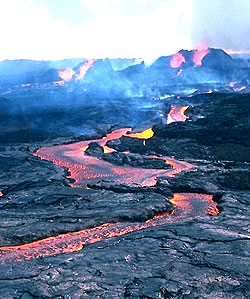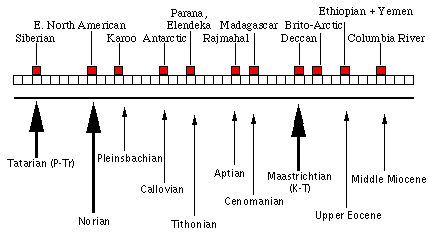Great Eruptions
in Earth History
 |
 |
Millions of square kilometres of the Earth's surface were covered
by flood-basalt eruptions in the Earth's past. Did the climate effects
of these eruptions contribute to mass extinctions? by
Steve Self
The great continental flood-basalt
eruptions of the geological past are the largest eruptions of lava
on Earth, with known volumes of individual lava flows exceeding
2000 cubic kilometres. For comparison, the ongoing eruption of Kilauea
volcano on Hawaii has produced just 1.5 cubic kilometres in 16 years!
A series of these huge eruptions builds up a thick stack of basalt
lava flows as shown in the photograph below.
Extending over areas of more than a million square
kilometres. Flood basalts are one type of large igneous province
(LIP) that characterise the Earth's surface and have been formed
at various times in the geological past - some in a submarine environment
and some on land. Notable examples are the Siberian Traps and the
Deccan Traps (trap is a Sanskrit word meaning 'step', referring
to the step-like topography produced by the stacked layers of lava).
The Columbia River province featured in the above photograph is
minute in comparision to the size of these enormous outpourings
of lava.
Mantle Plumes

Thor Thordarsson
Flood Basalts: Columbia River basalt lava flows in
the canyon of the Grande Ronde River, Washington State. Each
flow is 15-20m thick.
|
Large igneous provinces are thought to
be caused by the arrival of a mantle plume in the Earth's outermost
layer, the lithosphere. The plumes are proposed to be richer in lighter
elements and hotter than the surrounding mantle. As they rise, magma
(liquid rock) is generated by partial melting of the plume material.
The magma is injected into the lithosphere and erupted onto the Earth's
surface to form huge basalt lava flows. The first few million years
of a newly arrived mantle plume seem to be the most fertile in terms
of magma production and flood basalts are therefore formed in a very
short period of geological time.

USGS/Hawaiian Volcano Observatory
Basalt lava cascading over
the rim of a crater
|
Plumes are thought to originate very deep in the
Earth - perhaps at the core-mantle boundary for the larger ones
and at a depth of about 600 km deep for the smaller ones - but they
seem to be related to the breakup of continents (rifting), so there
is some influence from global plate tectonic processes.
The estimated dates of the younger continental flood
basalts compiled from recent sources along with other lines of evidence
suggest that in most instances the greatest number of individual
eruptions and the largest volumes of lava probably occurred within
a million years or less.
Flood Basalts & Mass Extinctions
Every now and again in geology, as in any other
science, evidence is obtained and presented that cannot easily be
explained in terms of familiar processes or accepted ideas. Such
a case was continental drift, proposed by Wegener in 1912, which
languished as a theory for about 45 years because there was no logical
explanation of HOW continents could move. The mechanism of seafloor
spreading proposed in the late 1950's led to the development of
the modern theory of plate tectonics, which provides an explanation
for continental drift.

USGS/Hawaiian Volcano Observatory
Could the catastrophe that
killed the dinosaurs have been volcanic?
|
The time relationship between flood
basalt province formation and mass extinctions of organisms is another
example of a scientific "hard nut to crack."
Extinction events are increasingly
seen as important factors in the history of life on Earth, and recent
studies suggest catastrophic causes for at least some mass extinctions.
Two catastrophic processes that have been invoked are (1) impacts
of asteroids or comets and (2) large volcanic eruptions. The end-Cretaceous
(Cretaceous/Tertiary or K/T boundary) mass extinction has been convincingly
correlated with the impact of a 10-km diameter asteroid with the
Earth about 65 million years ago. Evidence of similar impacts has
been found at the times of several other extinction events.
When you compare the age of LIPs with the estimated
ages of stratigraphic boundaries involving significant biotic changes
(dated according to the most recent geological time scale), in at
least three cases (the Deccan, Newark, and Siberian flood basalts),
a direct measure of correlation with major extinction events is
possible (see graph below). The probability that three major volcanic
events that typically last ~1 Myr should occur within 1 Myr of major
extinction events during the last 250 Myr (of which there are ~12)
is about 10-4. Thinking about the ways in which these
two types of global event might be causally linked is a worthy scientific
challenge.
|

Graph showing the apparent correlation between mass
extinctions and flood basalt eruptions
|
|
|
Environmental Effects of Flood Basalt
Eruptions
If there is a causal link between flood
basalt events and mass extinctions, it may lie in the environmental
impact of the gases released, because basalt eruptions are not particularly
explosive. Several kinds of environmental effects have been suggested,
including climatic cooling from sulphuric acid aerosols, greenhouse
warming from CO2 and SO2 gases, and acid rain. Basaltic magmas are
often very rich in dissolved sulphur, and sulphuric acid aerosols
formed from sulphur volatiles (largely SO2) are injected into the
stratosphere by convective plumes rising above volcanic vents and
fissures.
Indirect environmental effects include
changes in ocean chemistry, circulation, and oxygenation, especially
from basaltic volcanism associated with large submarine oceanic
plateaus that may represent flood basalt eruptions in an oceanic
environment.
A major uncertainty is the nature and
severity of the environmental effects of the eruptions and their
potential impact on life. Although the correlation between some
flood basalt episodes and extinctions may implicate volcanism in
the extinctions, it is also possible that other factors lead to
an apparent association. Flood basalt episodes have been attributed
to mantle plume activity, and thus may represent one facet of a
host of related global geological factors (eg, changes in sea-floor
spreading rates, rifting events, increased tectonism and volcanism,
sea-level variations) that tend to be correlated, and may be associated
with unusual climatic and environmental fluctuations that could
lead to significant faunal changes. It has also been suggested that
a coincidence of both a large impact and a flood basalt eruption
might be necessary in causing severe mass extinctions.

USGS/Hawaiian Volcano Observatory
Hawaii's eruptions are tiny
compared to ancient flood basalts.
|
Missing Pieces of the Puzzle
How often do flood basalt lavas occur? It
would be desirable to be able to obtain age dates on individual
lavas in a flood basalt pile to determine how often these huge eruptions
occurred, but the dating methods available at present do not have
sufficent accuracy to pinpoint individual flows in time - virtually
a whole flood basalt field fits within the errors on some of the
dates.
Were ancient flood basalts associated with major
outgassing? Due to their age and altered state, the amount and
signature of the minor volatile elements in these old lavas will
be difficult to obtain. It is possible to show whether the eruptions
degassed vast amounts of sulphur and carbon dioxide if these species
can be measured, as they can in some of the younger lavas such as
those in the Columbia River province. More accurate modelling of
dense atmospheric aerosol clouds, and their effects on atmospheric
dynamics and chemistry, is needed before the likely climatic impact
of events such as flood basalts can be properly estimated.
|
 |
Steve
Self is a Professor in the Department of Geology and Geophysics
at the University of Hawaii at Manoa. He is a contributor to the
NASA EOS programme and is a founder and the present leader of the
Hawaii Center for Volcanology.
This work is based on: M Rampino and
S Self, Volcanism and Biotic Extinctions, in The Encyclopedia of
Volcanology (ed. H Sigurdsson), Academic Press, San Diego, 1999
This work was first published by the
Geological Society.
You can find out more about Flood-basalts and volcanos in general
at Volcano
World. The United
States Geological Survey website contains a great deal of information
about the Geology of the United States including the Columbia River
Basalt and the Hawaii volcanos. |
|
|
